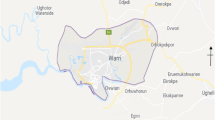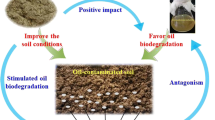Abstract
Refining oil contaminants are complex and cause serious harm to the environment. Remediation of refining oil-contaminated soil is challenging but has significant impact in China. Two plant species Agropyron fragile (Roth) P. Candargy and Avena sativa L. and one bacterium Bacillus tequilensis ZJ01 were used to investigate their efficiency in remediating the refining oil-polluted soil sampled from an oil field in northern China. The simulated experiments of remediations by A. fragile or A. sativa alone and A. fragile or A. sativa combined with B. tequilensis ZJ01 for 39 days and by B. tequilensis ZJ01 alone for 7 days were performed in the laboratory, with B. tequilensis ZJ01 added before or after the germination of seeds. Seed germination rates and morphological characteristics of the plants, along with the varieties of oil hydrocarbons in the soil, were recorded to reflect the remediation efficiency. The results showed that the contamination was weakened in all experimental groups. A. sativa was more sensitive to the pollutants than A. fragile, and A. fragile was much more resistant to the oil hydrocarbons, especially to aromatic hydrocarbons. Adding B. tequilensis ZJ01 before the germination of seeds could restrain the plant growth while adding after the germination of A. fragile seeds notably improved the remediation efficiency. The degradation rate of oil hydrocarbons by B. tequilensis ZJ01 alone was also considerable. Together, our results suggest that the unitary remediation by B. tequilensis ZJ01 and the binary remediation by A. fragile combined with B. tequilensis ZJ01 added after the germination of seeds are recommended for future in situ remediations.











Similar content being viewed by others
Abbreviations
- Afr :
-
Agropyron fragile (Roth) P.Candargy
- Asa :
-
Avena sativa L.
- Bte :
-
Bacillus tequilensis
- OS:
-
Original soil,
- FMA:
-
Fresh mass of the aerial part
- FMR:
-
Fresh mass of the root
- LR:
-
Length of the root
- DMA:
-
Dry mass of the aerial part
- DMR:
-
Dry mass of the root
- SH:
-
Saturated hydrocarbon
- AH:
-
Aromatic hydrocarbon
- RH:
-
Resin
- Asp:
-
Asphaltene
- TIC:
-
Total ion chromatogram
- MNR:
-
Methylnaphthalene rate
References
Al-Hawash AB, Alkooranee JT, Abbood HA, Zhang J, Sun J, Zhang X, Ma F (2018) Isolation and characterization of two crude oil-degrading fungi strains from Rumaila oil field, Iraq. Biotechnol Reports 17:104–109
Dos Santos JJ, Maranho LT (2018) Rhizospheric microorganisms as a solution for the recovery of soils contaminated by petroleum: a review. J Environ Manag 210:104–113
Du WD, Wan YY, Zhong NN, Fei JJ, Zhang ZH (2011) Current status of petroleum-contaminated soils and sediments. J Wuhan Univ (Sci Ed) 57:311–322
Du W, Wan Y, Yong Z, Fei J, Zhang Z, Zhong N (2012) Evaluation and simulation research on soil environmental capacity of petroleum pollution. Environ Protect Oil Gas Fields 22:6–10
Fatima K, Imran A, Amin I, Khan QM, Afzal M (2016) Plant species affect colonization patterns and metabolic activity of associated endophytes during phytoremediation of crude oil-contaminated soil. Environ Sci Pollut Res 23:6188–6196
Fei JJ, Wan YY, Du WD, Wang XW, Zhang ZH, Zhong NN, Wang TG (2017a) Analysis of polycyclic aromatic hydrocarbon in ambient air. Environ Protect Oil Gas Fields 27:5–8
Fei JJ, Zhang ZH, Wan TT, He FP (2017b) Effects of organic carbon content on the residue and migration of polycyclic aromatic hydrocarbons in soil profiles. Environ Sci 38:1–14
Ghoreishi G, Alemzadeh A, Mojarrad M, Djavaheri M (2017) Bioremediation capability and characterization of bacteria isolated from petroleum contaminated soils in Iran. Sustain Environ Res 27:195–202
Hatami E, Abbaspour A, Dorostkar V (2019) Phytoremediation of a petroleum-polluted soil by native plant species in Lorestan Province, Iran. Environ Sci Pollut R 26:24323–24330
He XY (2017) Bioremediation of petroleum-contaminated soils with plant, fungi and laccase. China University of Petroleum (Beijing), Beijing
Hou J, Liu W, Wang B, Wang Q, Luo Y, Franks AE (2015) PGPR enhanced phytoremediation of petroleum contaminated soil and rhizosphere microbial community response. Chemosphere 138:592–598
Hussain I, Puschenreiter M, Gerhard S, Schöftner P, Yousaf S, Wang A, Syed JH, Reichenauer TG (2018) Rhizoremediation of petroleum hydrocarbon-contaminated soils: improvement opportunities and field applications. Environ Exp Bot 147:202–219
International Plant Name Index (2020) https://www.ipni.org/
John KV, Robert A, Robert IK, Steven JR, Peter NS (1984) Biodegradation of aromatic hydrocarbons in crude oils from the Barrow sub-basin of Western Australia. Org Geochem 6:619–632
Lim MW, Lau EV, Poh PE (2016) A comprehensive guide of remediation technologies for oil contaminated soil — present works and future directions. Mar Pollut Bull 109:14–45
Liu Y, Wan YY, Wang C, Ma Z, Liu X, Li S (2020) Biodegradation of n-alkanes in crude oil by three identified bacterial strains. Fuel:275
Mao G, Shi T, Zhang S, Crittenden J, Guo S, Du H (2018) Bibliometric analysis of insights into soil remediation. J Soils Sediments 18:2520–2534
Marques APGC, Oliveira RS, Samardjieva KA, Pissarra J, Rangel AOSS, Castro PML (2007) Solanum nigrum grown in contaminated soil: effect of arbuscular mycorrhizal fungi on zinc accumulation and histolocalisation. Environ Pollut 145:691–699
Murphy HF (1929) Some effects of crude petroleum on nitrate production, seed germination and growth. Soil Sci 27:117–120
O'Brien PL, Desutter TM, Casey FXM (2019) Natural degradation of low-level petroleum hydrocarbon contamination under crop management. J Soils Sediments 19:1367–1373
Ogboghodo IA, Iruaga EK, Osemwota IO, Chokor JU (2004) An assessment of the effects of crude oil pollution on soil properties, germination and growth of maize (Zea mays) using two crude types - Forcados light and Escravos light. Environ Monit Assess 96:143–152
Peters KE, Walters CC, Moldowan JM (2005) The biomarker guide volume2, biomarkers and isotopes in petroleum systems and earth history. Cambridge University Press
Rajtor M, Piotrowska-Seget Z (2016) Prospects for arbuscular mycorrhizal fungi (AMF) to assist in phytoremediation of soil hydrocarbon contaminants. Chemosphere 162:105–116
Ramirez MI, Arevalo AP, Sotomayor S, Bailon-Moscoso N (2017) Contamination by oil crude extraction – refinement and their effects on human health. Environ Pollut 231:415–425
Shen YY (2012) Study on the behavior characteristics of petroleum containment in the soil and rhizoremediation. Chang'an University, Xi an
Sun J, Pan L, Tsang DCW, Zhan Y, Zhu L, Li X (2018) Organic contamination and remediation in the agricultural soils of China: a critical review. Sci Total Environ 615:724–740
Tatem HE, Cox BA, Anderson JW (1978) The toxicity of oils and petroleum hydrocarbons to estuarine crustaceans. Estuar Coast Mar Sci 6:365–373
Tianjin Municipal Bureau Of Statistics (2016) Tianjin statistical yearbook. China Statistics Press. http://stats.tj.gov.cn/nianjian/2016nj/zk/indexch.htm
Tracey AJ, Stephens KA, Schamp BS, Aarssen LW (2016) What does body size mean, from the "plant's eye view"? Ecol Evol 6:7344–7351
Udo EJ, Feyemi AAA (1975) Effect of oil pollution of soil on germination growth and nutrient update of corn. J Environ Qual 4:537–540
Varjani SJ (2017) Microbial degradation of petroleum hydrocarbons. Bioresour Technol 223:277–286
Wake H (2005) Oil refineries: a review of their ecological impacts on the aquatic environment. Estuar Coast Shelf Sci 62:131–140
Wan YY, Dong HL (2014) Environmental Geomicrobiology experiments. Petroleum Industry Press, Beijing
Wan YY, Du WD (2017) New approaches and technologies for prevention and control of petroleum-contaminated soils and sediments. Petroleum Industry Press, Beijing
Wan YY, Zhu YJ, Fei JJ, Du WD, S XY, Zhang QB, H ZZ, N ZN, Wang TG (2017) The structure of polycyclic aromatic hydrocarbons and its danger in the environment. Environ Protect Oil Gas Fields 27:23–26
Wu M, Li W, Dick WA, Ye X, Chen K, Kost D, Chen L (2017) Bioremediation of hydrocarbon degradation in a petroleum contaminated soil and microbial population and activity determination. Chemosphere 169:124–130
Xie W, Zhang Y, Li R, Yang H, Wu T, Zhao L, Lu Z (2017) The responses of two native plant species to soil petroleum contamination in the Yellow River Delta, China. Environ Sci Pollut R 24:24438–24446
Yu D (2015) The study on factors controlling the biodegradation of alkyl polycyclic aromatic hydrocarbons in crude oils. Zhejiang University, Hangzhou
Funding
This study was supported by grants from the National Major Science and Technology Project (2016ZX05050011, 2016ZX05040002), PetroChina Major Strategic Cooperation Projects (ZLZX2020010805, ZLZX2020020405), Forward Looking Foundation of China University of Petroleum-Beijing (ZX20190209), and Beijing Nova Program and Leading Talent Culturing Cooperative Projects (Z161100004916033).
Author information
Authors and Affiliations
Corresponding authors
Additional information
Responsible Editor: Elena Maestri
Publisher’s note
Springer Nature remains neutral with regard to jurisdictional claims in published maps and institutional affiliations.
Rights and permissions
About this article
Cite this article
Fei, J.J., Wan, Y.Y., He, X.Y. et al. Unitary and binary remediations by plant and microorganism on refining oil-contaminated soil. Environ Sci Pollut Res 27, 41253–41264 (2020). https://doi.org/10.1007/s11356-020-10025-6
Received:
Accepted:
Published:
Issue Date:
DOI: https://doi.org/10.1007/s11356-020-10025-6




